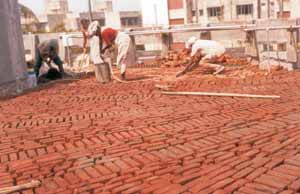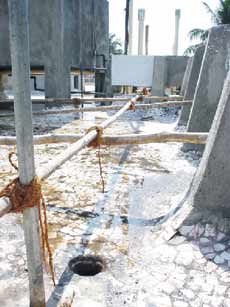|
SPECIALIST IN BUILDING REPAIRS |
☎ 98406 24976
|
| Terrace Waterproofing |
|
Brick Bat
Water Proofing Treatment


• Existing waterproofing treatment
shall be removed till RCC slab is exposed. Surface of the
slab shall then be inspected. If any honeycombing or cracks
are observed then these shall be treated as per specification
for treating cracks.
• Entire slab surface shall then be grouted with cement
slurry made with 1 part cement and 0.60-part water. This
type of grouting is surface grouting onlyand not deep into
the body. This slurry shall be spread over the slab surface
and brushed into concrete using squeegee, brooms and brushes.
• The surface shall then be covered with cement + clean
sand mix in proportion 1:4 by volume with a waterproofing
plasticizer added at recommended dosages. The thickness
is about 25-40 mm.
• Brick bats shall then be laid on fresh mortar starting
with brick on edge at the central portion and gradually
using smaller brick bat pieces as one goes to the rain water
down take pipe side. The levels should be so adjusted that
an overall slope of finished Brick Bat Coba of 1:100 is
achieved. Preferably water should be drained along both
longer sides of the building so that the water travel path
on terrace is shortest. Gaps between brick bat pieces should
not be more that 20 mm. Brick bat surface shall then be
cured for 7 days by ponding water over it.
• After curing period of brick bats the top screed shall
be laid in 1:4 cement sand mortar with a suitable waterproofing
plasticizer and polypropylene fibers 125 gms per bag of
cement. Surface shall be finished smooth and marked with
tile marks at 300 mm c/c both ways. The surface shall be
ponded for 21 days for curing. Final slope of min 1:100
shall be ensured. There should be no accumulation of water
anywhere over the terrace.
• The junction of parapet and side wall plaster should have
the coving (watta) or rounding as shown in sketch. The invert
level of rain water down take pipes should be minimum 1"
below the finished coba surface near parapet.

• China Mosaic tiles can be optionally applied at the top
and are not necessary.

The water overflowing from the
overhead watertank is seen flowing on the slope and escaping
through the hole made for rain water outlet pipe.
This check ensures that in the
monsoon, rain water will similarly make way along the slope.
|
|
|